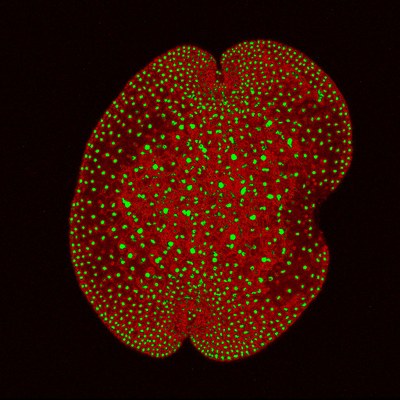
Figure: ARF1 protein in Marchantia, the on-off switch is marked with a fluorescent protein. Credit: Shubhajit Das, Lab of Biochemistry, Wageningen University & Research.
Cerdanyola del Vallès, August 17th 2020. The research team from Wageningen University, in the Netherlands, the Alba Synchrotron and the University of Kyoto shows that the enormously complex response to the plant hormone auxin can be reduced to a very simple switch-like model. Basically, auxin toggles one gene switch from 'off' to 'on," and at the same time, a second factor competes with this switch and thereby determines how sensitive each cell is to the hormone. Therefore, the numerous ways that plant cells react to auxin, whether it is a root branch or the formation of a flower, depend on the combination of an on/off switch with a volume control knob.
The small auxin molecule is known to control many aspects of plant growth and development, and does so by changing the activity of many genes. DNA-binding Auxine Response Factors (ARF) proteins bind to genes and switch these on or off, and auxin determines whether ARF proteins are active or not. Most plants have many different copies of the ARF proteins, derived from duplicating genes during evolution, followed by changes in their properties. What follows is a very complex web of ARF proteins that can trigger unique responses to the same hormone.
The team studied the auxin response system of the liverwort Marchantia polymorpha. This plant is an early land plant and has the simplest possible auxin response system, as the researchers described in an earlier paper in eLife. In the new study in Nature Plants, the team now made use of the extreme simplicity of the Marchantia auxin response system, and dissected its workings through a combination of genetics and protein biochemistry. The work revealed a very simple design of two competing ARF proteins to be at the heart of the auxin system.
Researchers analyzed the ARFs crystal structure at the XALOC beamline in the ALBA Synchrotron.
Fundamental view change for auxin
"We believe that our finding will fundamentally change the way researchers view the workings of the important auxin hormone," says Dolf Weijers, head of the Laboratory of Biochemistry at the Wageningen University and leader of the research team. "At the same time, this leap in our understanding of how cells respond to the hormone gives unprecedented new abilities to modify cellular hormone responses in crop plants, where propagation, rooting and many other traits depend on auxin response."
Fooled by complexity
For decades, studies in flowering plants, including the model plant Arabidopsis, have led to the idea that plants use a very complex network of response factors to allow different plant cells to respond in different ways to the same hormone. In this way, some cells will grow, others divide, yet others differentiate. It is also thought to allow the same hormone to trigger root formation and flower formation, depending on where in the plant the response to the hormone occurs. Now, the research team describes their discovery of a very simple principle underlying the complex responses to the plant hormone auxin. It is likely that the same simple principle operates in other plant species, that have large families of ARF proteins. The present study thus helps to better understand how plants, including crops, respond to the hormone.
Reference: Hirotaka Kato et al. Design principles of a minimal auxin response system, Nature Plants (2020). DOI: 10.1038/s41477-020-0662-y
Link to the original news: https://phys.org/news/2020-05-biologists-simple-principle-responses-hormone.html




